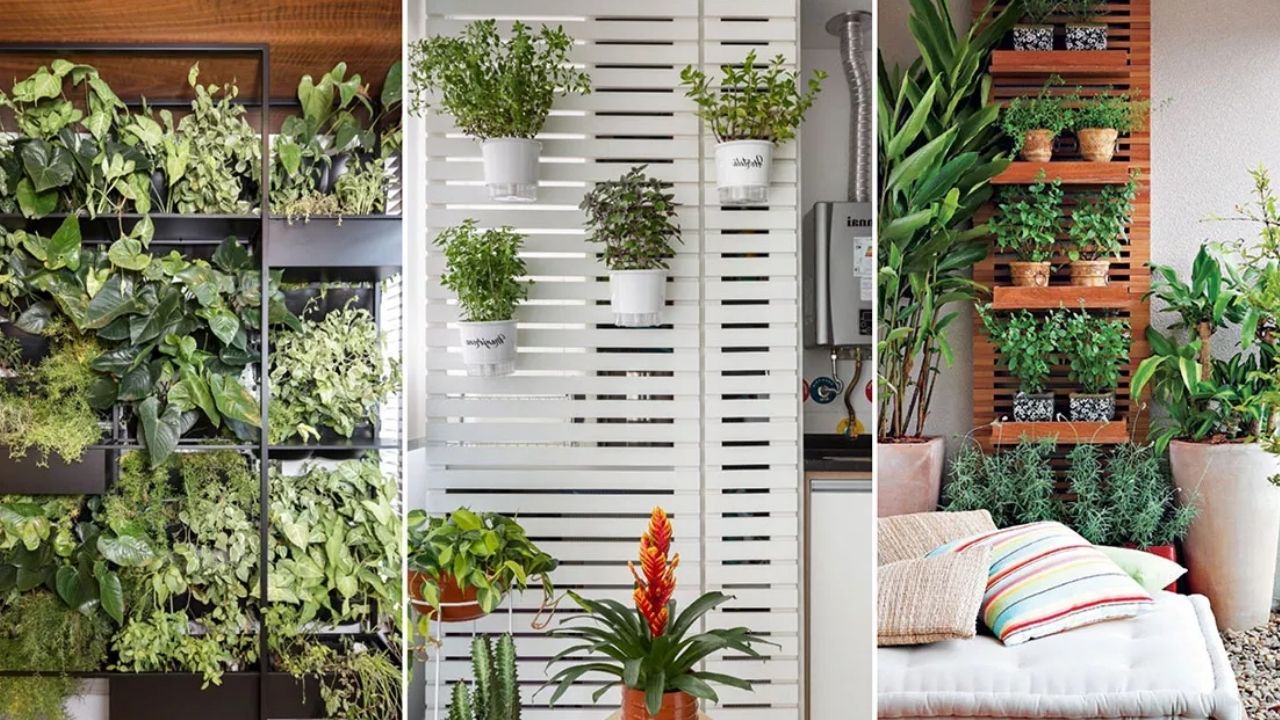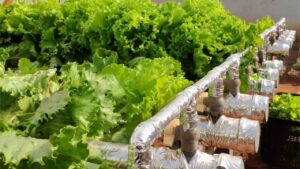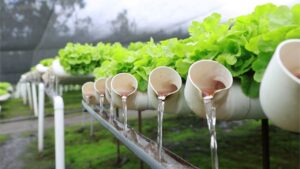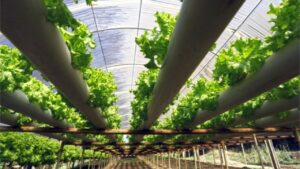In recent years, vertical and hydroponic gardens have increasingly captured the hearts of urban gardening enthusiasts. These innovative practices offer an efficient solution to grow fresh food in spaces with limited room, such as balconies and walls. Vertical gardens use vertical space, allowing you to grow a variety of plants without taking up large areas, while hydroponics eliminates the need for soil, offering a more sustainable and practical way to grow.
In cities that are becoming more densely populated with limited space, hydroponic vertical gardens have emerged as an excellent alternative for those who want to grow their own herbs, vegetables, and even flowers without compromising on practicality and aesthetics. The combination of hydroponic techniques with vertical structures makes these gardens the ideal choice for balconies, walls, and other areas where space is tight.
In this article, we will explore practical and creative ideas to transform these small spaces into true urban oases. If you want to learn how to create your own hydroponic vertical garden at home, keep reading and discover solutions that fit any environment!
What Are Vertical Hydroponic Gardens?
Vertical hydroponic gardens combine two innovative techniques in the world of urban gardening: hydroponics and vertical cultivation. Let’s dive into each of these concepts.
Hydroponic Garden
Hydroponics is a method of growing plants without soil. Instead, plants are nourished by a solution of nutrients dissolved in water. This system provides a controlled environment where plants can obtain all the necessary nutrients directly from the water. Hydroponics is known for its efficiency in water and space use, as well as allowing cultivation in areas where soil may not be ideal, such as urban spaces or even indoors.
Vertical Cultivation
Vertical cultivation is a technique that utilizes available vertical space, using structures like shelves, walls, grids, and other supports to grow plants at different levels. Instead of taking up large areas of soil, this method allows you to maximize the available space, creating a “vegetation wall” that can be placed on balconies, terraces, or even fences. Vertical cultivation is perfect for those with limited space but who want to grow a variety of plants.
Benefits of Growing in Vertical Hydroponic Systems
The combination of these two techniques offers a range of advantages. The first benefit is space efficiency. Vertical gardens allow you to grow more plants in a reduced space, making them ideal for balconies or any area with limited room. Additionally, hydroponic systems are highly efficient in water use, as the water circulates constantly within the system and is reused, significantly reducing waste.
Another great benefit is the ability to grow plants in a sustainable way. Since there is no soil involved, you don’t need to worry about soil degradation or the use of chemical pesticides, as the controlled environment allows for cleaner and more organic cultivation. Furthermore, cultivation in vertical and hydroponic systems tends to be faster, with accelerated growth due to precise control over nutrients and water.
In summary, vertical hydroponic gardens provide an efficient, sustainable, and practical solution for growing plants in urban environments, making them ideal for anyone looking to maximize the use of small spaces while contributing to a greener, healthier lifestyle.
How Do Vertical Hydroponic Gardens Work?
Vertical hydroponic gardens are an efficient and innovative system for growing plants in small spaces. To understand how they work, it’s important to grasp the workings of hydroponic systems and the concept of vertical cultivation. Below, we’ll detail how these two techniques come together to create a functional and productive garden.
How Hydroponic Systems Work
The hydroponic technique, in which soil is replaced with a nutrient solution, involves providing plants with essential minerals and water directly to their roots. This method offers several advantages, such as water conservation and the ability to control exactly what nutrients the plants receive, which speeds up their growth and improves their health. The plant roots are suspended in the nutrient solution or an inert substrate, such as expanded clay, which helps stabilize the roots and allows for necessary drainage and aeration.
By not using soil, hydroponic gardens avoid issues like soil pests and diseases, offering a clean and controlled environment for plant growth. Additionally, hydroponic cultivation uses much less water than traditional gardening methods, making it a sustainable and efficient choice.
Types of Vertical Hydroponic Systems
There are several ways to apply hydroponics in a vertical system. Here are some of the most common types:
- Growing Towers Growing towers are vertical structures made of stacked tubes or containers where plants grow on different levels. The nutrient solution circulates from top to bottom, watering the plants while flowing through each level of the tower. This type of system is ideal for those with limited space as it uses minimal horizontal area.
- Green Walls Green walls are large vertical surfaces, often covered with mesh or structures that hold the plants. In these systems, plants grow in a layer of substrate or directly on the wall, with the nutrient solution being applied via an automated irrigation system. They are perfect for transforming a blank wall or balcony fence into a productive vertical garden.
- Vertical Tubes The vertical tube system uses PVC pipes or similar materials arranged vertically, with the nutrient solution circulating through the pipes. Plants are placed in holes along the tubes, allowing them to grow at different levels. This system is compact and efficient, ideal for urban gardens.
Essential Equipment
To set up a vertical hydroponic garden, some basic equipment is needed. Here are the main components:
- Reservoir The reservoir is where the nutrient solution is stored. It should be large enough to ensure the plants have enough to grow but also easy to access for monitoring and replenishing the nutrients.
- Water Pump The water pump is responsible for circulating the nutrient solution through the system. In vertical systems, it ensures that water reaches all levels of the garden, irrigating the plants evenly.
- Substrate The substrate is an inert material, such as expanded clay or rock wool, that helps support the plant roots. While the substrate doesn’t provide nutrients, it offers structural support, drainage, and aeration for the roots, keeping them healthy.
- Nutrients The nutrients are a mixture of dissolved mineral salts in the water, providing the essential elements for plant growth. In hydroponic systems, nutrients are carefully balanced to ensure that plants receive everything they need to develop properly.
- Vertical Supports Vertical supports are structures that hold the plants up and organize them into different levels. These supports can be made from various materials, such as wood, metal, or plastic, and are designed to hold plants in vertical positions, allowing them to grow efficiently.
With these components, vertical hydroponic gardens operate efficiently and sustainably, providing an ideal environment for growing plants in reduced spaces. If you’re interested in creating your own vertical garden, understanding how these systems work and the equipment needed is the first step to successful urban cultivation.
- See Also: Incredible Benefits of Hydroponic Farming You Need to Know
- Follow Us: https://www.facebook.com/profile.php?id=61565885846819
Benefits of a Vertical Hydroponic Garden on Balconies and Walls
Vertical hydroponic gardens offer an innovative and sustainable solution for growing fresh food in urban spaces, such as balconies and walls. By integrating these gardens into urban environments, you not only make the most of the available space but also contribute to a more sustainable and aesthetically pleasing lifestyle. Let’s explore the main benefits of this practice.
Maximizing Vertical Space
One of the greatest advantages of vertical hydroponic gardens is the smart use of space. In small areas like balconies and walls, traditional gardening can be challenging due to limited ground space. With vertical gardens, you can grow a large amount of plants in a small area by utilizing the height of walls and vertical structures. This allows you to grow a variety of plants, such as herbs, vegetables, and even flowers, without taking up much floor space.
For example, systems like growing towers and green walls are ideal for those who want to grow food on balconies where soil may not be available or sufficient. By elevating the plants, these systems not only maximize space usage but also make plant care easier, making gardening more accessible and efficient.
Sustainability and Water Conservation
In an increasingly environmentally conscious world, vertical hydroponic gardens stand out for their reduced environmental impact. Hydroponic cultivation uses much less water than traditional gardening methods, as the water is recirculated through the system, significantly reducing waste. In urban areas, where water can be a scarce resource, this water conservation is a major benefit.
Moreover, these gardens provide the opportunity to grow fresh food at home, reducing the need for food transportation and the environmental impact associated with food production and distribution. By growing your own herbs and vegetables, you can also ensure that you’re consuming food without pesticides, promoting healthier and more sustainable eating.
Aesthetic and Decoration
Vertical hydroponic gardens are not only practical and efficient but also an excellent way to transform the look of a balcony or wall. These systems can be designed to seamlessly blend into the style of the space, offering a unique aesthetic that combines functionality and beauty. A green wall or growing tower can create a focal point on your balcony, adding life, color, and freshness to the environment.
The plants grown in vertical systems can be chosen to complement the design of your home, whether with aromatic herbs, colorful vegetables, or vibrant flowers. Additionally, these vertical gardens contribute to improving the air quality around your home, making the space more pleasant and healthy. The presence of plants also has psychological benefits, promoting well-being and creating a more relaxing and inviting space.
Investing in a vertical hydroponic garden for your balcony or wall is an excellent way to maximize the available space, promote sustainability, and transform your environment. Not only can you grow fresh food at home in an efficient and eco-friendly way, but you can also enjoy a lively and engaging decoration. If you’re looking to optimize your urban space and adopt a greener lifestyle, vertical gardens are the ideal solution.
5 Creative Ideas for Vertical Hydroponic Gardens on Balconies and Walls
Vertical hydroponic gardens offer endless possibilities for those looking to grow fresh food in small spaces, such as balconies and walls. Below are five creative ideas that can transform these areas into productive and sustainable spaces.
1. Vertical Hydroponic Tower
The vertical hydroponic tower is a compact and efficient model that uses vertical structures to grow plants at different levels. This system is perfect for small spaces as it can be placed in corners or narrow areas. The growing towers are made of stacked tubes or containers, with the nutrient solution circulating from top to bottom.
Advantages: The tower allows you to grow a variety of plants in a small space by making use of vertical height. It’s ideal for growing herbs, lettuce, and even strawberries.
Ideal Plants: Herbs like basil, rosemary, and mint, as well as lettuce and strawberries, are perfect for this system. These types of plants adapt well to limited space and the continuous flow of nutrients.
2. Vertical Gutter System
The vertical gutter system uses tubes or wood arranged vertically to create channels through which the nutrient solution flows and waters the plants. This system can be easily built at home using materials such as PVC or treated wood and is great for optimizing space on balconies.
How to Build: Simply fix the gutters to the wall or set up a standalone structure. Plants are placed in small compartments along the gutters, and the nutrient solution is poured from the top, circulating down to the bottom.
Best for Leafy Greens and Vegetables: This system is especially efficient for growing leafy greens and vegetables such as spinach, arugula, small carrots, and tomatoes, which adapt well to the narrow space of the gutters.
3. Hydroponic Green Wall
The hydroponic green wall transforms a vertical surface into a garden of plants that grow in a soil-free system. This type of gardening is perfect for those who want to create a green and fresh environment on their balcony while also growing food.
How to Set Up: To create a hydroponic green wall, you can use panels or grids attached to the wall, where the plants will be placed. The nutrient solution is distributed through tubes or hoses connected to these panels.
Plants that Adapt Well: Herbs like basil, thyme, and oregano, along with lettuce and even edible flowers like nasturtiums, adapt well to this type of cultivation.
Design Tips: Use different levels or compartments to add texture and depth to the green wall. Combine plants with varying colors and shapes to create a dynamic and vibrant look.
4. Modular Vertical Garden
The modular vertical garden is a versatile solution that allows you to build a customized garden based on your needs and available space. By using modular units, you can create different configurations and adjust the system according to the types of plants you wish to grow.
How It Works: The modules can be stacked or placed side by side to form a vertical structure that can be tailored to the space. Each module can be dedicated to a specific type of crop.
Maximize Each Module: In one module, you can grow herbs, in another, leafy vegetables, and in another, fruits or flowers. The flexibility of the system allows you to maximize space usage and have a diverse and organized garden.
5. Pallet or Grid Structures
Repurposing recycled materials like wooden pallets or metal grids is a creative and sustainable way to create a vertical garden. These materials can be transformed into functional plant supports, adding a rustic touch to the environment.
How to Use: Pallets can be fixed to the wall or used as a base to support plant pots or compartments. Metal grids can also be adapted for this type of cultivation, allowing plants to grow at different levels.
Rustic Aesthetic and Functionality: In addition to being functional, these structures offer a rustic and charming aesthetic, perfect for those looking for a natural or industrial style on their balcony. The combination of functionality and rustic design transforms your space into a cozy and productive environment.
These five creative ideas for vertical hydroponic gardens on balconies and walls provide practical and aesthetically pleasing solutions for growing your own food in urban spaces. Try different models and make the most of your available space, creating a sustainable and green environment at home!
Tips for Maintaining Your Vertical Hydroponic Garden
Maintaining a healthy vertical hydroponic garden requires some specific care, but with the right practices, you can ensure that your plants grow strong and productive throughout the year. Here are some essential tips to keep your garden running smoothly:
1. Monitoring pH and Nutrient Levels
Maintaining the correct pH and nutrient levels is critical for the success of a hydroponic garden. The ideal pH for most hydroponic plants ranges from 5.5 to 6.5. Values outside this range can affect nutrient absorption by the plants.
How to Monitor: Use pH test kits or digital meters to check the pH of the nutrient solution. If necessary, adjust the pH using specific products such as acid or base, available in gardening stores. Additionally, regularly check the levels of key nutrients, such as nitrogen, phosphorus, and potassium, to ensure they are balanced.
2. The Importance of Lighting and Ideal Temperature
Lighting and temperature are crucial factors for healthy plant growth. Vertical hydroponic gardens typically require good lighting, especially if grown indoors.
Lighting: If your garden is in a location with little natural light, consider investing in LED grow lights that emit the necessary light for plants. The light should be on for about 12 to 16 hours per day, depending on the type of plant.
Temperature: The ideal temperature for most hydroponic plants ranges from 18°C to 24°C (64°F to 75°F). In extremely hot or cold environments, plant growth can be hindered, so monitor the temperature regularly and use fans or heaters if needed.
3. Preventing Diseases and Pests in Hydroponic Systems
Although hydroponic systems are generally cleaner and less susceptible to pests than traditional growing methods, it’s still important to monitor the environment closely to avoid infections and infestations.
How to Prevent: Regularly inspect your plants for signs of pests, such as damaged leaves or spots. To prevent diseases, keep the system clean and avoid allowing standing water for long periods. Organic pest control products, like neem oil, can be helpful.
Cleaning Tip: Clean the reservoir and tubes of the system every 2 to 3 weeks to prevent algae and other contaminants from building up. This will help maintain a healthy environment for your plants.
4. Winter and Summer Care: Plant Adaptation
Hydroponic vertical plants need special care during seasonal changes, especially in winter and summer when temperatures can be extreme.
In Winter: During winter, growing can be challenging due to lack of light and lower temperatures affecting plant growth. If your garden is indoors, invest in additional lighting and keep the temperature stable. If it’s outdoors, consider covering the garden with a tarp or structure to protect it from extreme cold.
In Summer: Summer can be easier, but high temperatures can stress the plants, especially if the system isn’t well ventilated. On very hot days, avoid letting the nutrient solution heat up, as this can harm the roots. Use fans to improve air circulation and protect plants from excessive heat.
With a little attention to detail and regular care, your vertical hydroponic garden can thrive all year round. By monitoring pH levels, maintaining ideal lighting and temperature, preventing diseases and pests, and adapting plants to the seasons, you can ensure that your garden remains healthy and productive. By following these tips, you can make the most of your hydroponic garden, harvesting fresh and healthy food right from your home!
Conclusion
Additionally, the aesthetic appeal of vertical gardens can transform any space, adding a touch of greenery and vitality to your urban environment.
Now that you’re familiar with various creative and practical ideas for setting up your own vertical hydroponic garden, it’s time to start transforming your space. Whether it’s building a compact growing tower, creating a green wall, or setting up a modular system, there are many ways to bring nature indoors, even in the smallest of spaces.
Now it’s your turn! Try out the ideas presented in this article, share your own creations, or start planning your vertical hydroponic garden project. If you already have a garden at home, tell us how it’s going and inspire other readers with your tips and experiences. There are no limits to creativity when it comes to growing your own urban garden!




